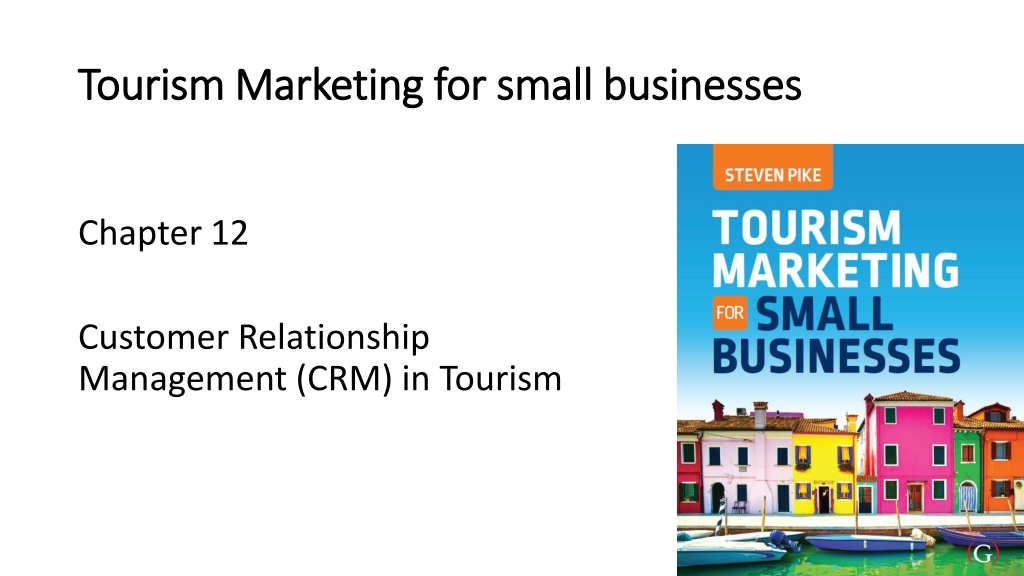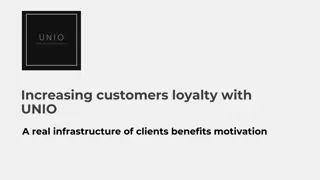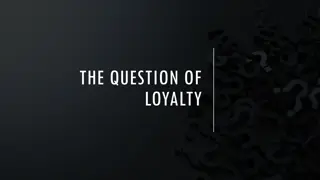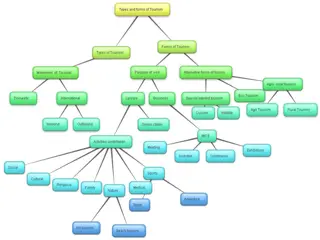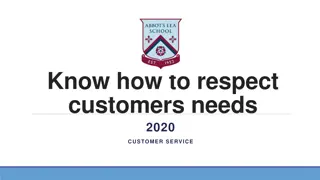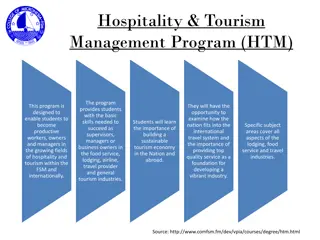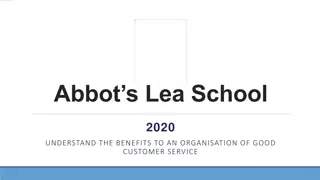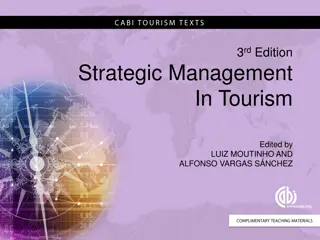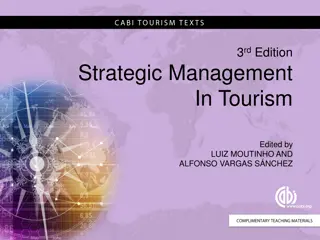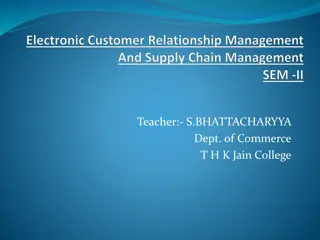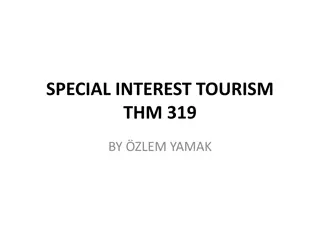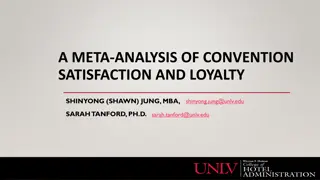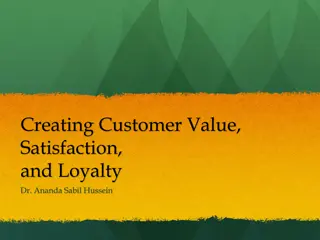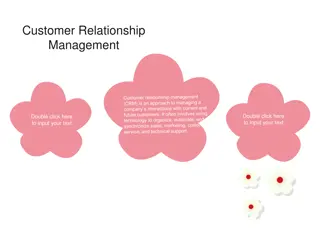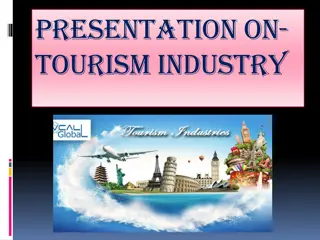Customer Relationship Management in Tourism: Enhancing Loyalty and Referrals
Explore the significance of Customer Relationship Management (CRM) in the tourism sector, focusing on customer loyalty programs, word-of-mouth referrals, and the distinction between customer satisfaction and loyalty. Understand the key terms and forms of customer loyalty to cultivate repeat business and positive recommendations for small tourism businesses to thrive.
Download Presentation

Please find below an Image/Link to download the presentation.
The content on the website is provided AS IS for your information and personal use only. It may not be sold, licensed, or shared on other websites without obtaining consent from the author. Download presentation by click this link. If you encounter any issues during the download, it is possible that the publisher has removed the file from their server.
E N D
Presentation Transcript
Tourism Marketing for small businesses Tourism Marketing for small businesses Chapter 12 Customer Relationship Management (CRM) in Tourism
Chapter learning aims Chapter learning aims To enhance your understanding of: the rationale for customer relationship management (CRM) the fundamentals of an effective customer loyalty programme opportunities to stimulate word-of-mouth (WoM) referrals
Key terms Key terms Loyalty The commitment by a customer to return to the business to make further purchases, and/or to recommend the business to others. Customer relationship management (CRM) A philosophy, technology, strategy and tactics, making use of customer information to stimulate increased customer loyalty. Word-of-mouth (WOM and eWOM) referrals A powerful organic source of brand image development that occurs naturally, and where a firm can actively encourage satisfied customers to create conversations about the brand with others in their network. Also known as influencer marketing.
Customer loyalty Customer loyalty The ultimate aim of any promotion is to generate customers (sales). The greater the amount of sales that are in the form of repeat purchases, the greater the benefits for the business. Small tourism businesses put in a lot of effort to attract new customers, who should then be regarded as a resource for the firm to capitalise on for mutual benefit.
Customer loyalty Customer loyalty Customer loyalty shouldn t be confused with customer satisfaction Loyalty is built on satisfaction, but satisfaction doesn t always lead to loyalty Satisfaction is a perception about how needs were met during a past service transaction, whereas loyalty is future behavioural intention/action. A customer could be very satisfied with a service, and yet quite easily switch to another brand offering a cheaper deal, or not be in a position to visit the business again.
Two forms of customer loyalty Two forms of customer loyalty Behavioural loyalty Repeat visitation/purchases Word-of-mouth recommendations to others Attitudinal loyalty Extent to which an individual intends to make a repeat purchase Likelihood an individual will recommend the business to others
CRM rationale CRM rationale A customer relationship management (CRM) programme that increases customer loyalty is valuable to the business because it reduces marketing costs and increases yield. An effective CRM programme is not only a potential source of competitive advantage, but is also an intangible asset on the balance sheet that adds to the financial value of the brand. Loyalty programmes offering economic incentives can have a positive effect on customer satisfaction, customer retention and market share
Loyalty programme Loyalty programme For businesses operating in markets where there is potential for repeat visitation The starting point is to set up a customer database It can be more efficient use of scarce promotional resources to stay in touch with previous customers, than only attempt to attract the attention of consumers with costly mass media advertising. It makes sense then to supplement the promotional plan objectives to increase new customers, with a customer relationship management (CRM) programme to foster increased loyalty.
Loyalty programme Loyalty programme The key aims of CRM are to increase customer retention and stimulate repeat purchases CRM can be used boost capacity, increase the contribution towards fixed costs of the business, and save on marketing costs. It can be at least five times more cost-effective to retain existing customers, rather than continually acquiring new ones
Loyalty programme Loyalty programme General performance indicators Increased purchase frequency Decreased customer price sensitivity Customer advocacy Extended relationship lengths Increased share of wallet Development of consumer community and connectedness Increased firm performance Key challenge is directly quantifying the relationship between the costs of CRM and firm performance Many sophisticated CRM programmes for large firms have failed Due high costs Due incorrect strategy
Five fundamentals of effective CRM Five fundamentals of effective CRM 1. Develop a philosophy of nurturing long term mutually beneficial customer relationships that foster a sense of community and belonging While a feature of a loyalty programme is rewards, the focus should be developing relationships Aim is to make the cost of switching brands expensive for the customer Benefits of a relationship should outweigh the costs to the business Therefore, not all customers
Five fundamentals of effective CRM Five fundamentals of effective CRM 2. Develop a customer database CRM is reliant on customer information Recorded transactions provide the business with information on purchases and effectiveness of rewards initiatives such as a short term coupon offer This is a repository of customers information that can be accessed by sales staff and service staff Small businesses can get closer to their customers than big firms Database doesn t have to be technologically complex or expensive
Five fundamentals of effective CRM Five fundamentals of effective CRM 3. Select customers who offer maximum yield Not feasible to develop a relationship with every customer Identify those who are less price sensitive, and less likely to switch brands for a better deal Selection criteria includes: frequency and volume of purchase, spending patterns and probability of future visitation A tier system can be developed to differentiate members by their value level Importantly, select those profitable customers that the business is best able to cater to their needs.
Five fundamentals of effective CRM Five fundamentals of effective CRM 4. Provide added value to loyal customers Financial rewards are essential Can be short term (eg make a purchase and receive a reward) Or long term (eg repeat purchase points accrue towards a prize target) A tiered system provides enhanced sense of status
Options include: Exclusive offers Service upgrades Priority seating Exclusive opportunities to preview new service and product offerings Preferential reservation contact number Guaranteed reservations at any time Members only events Special dedicated amenities such as a members lounge
Five fundamentals of effective CRM Five fundamentals of effective CRM 5. Communicate with loyal customers via direct media in a meaningful way Mass distribution of customer newsletters are useful But effective CRM involves personalised messages Based on the customer s personal information in the database Eg special offers related to their purchase preferences Eg targeting previously frequent customers who are overdue for a visit
Eg Special offers to customers on the database who have reported a negative service experience. Eg Competitions that acknowledge customers tier status Eg An off-peak offer of added value that recognises the customer s personal preferences Eg An email seeking feedback on the recent service Eg Birthday and anniversary special offers
Stimulating word Stimulating word- -of of- -mouth ( mouth (WoM WoM) ) Delighted customers can be an asset to the business, even if they are unlikely to return themselves Exceeding a customer s expectations is the foundation of WoM Difficult to keep exceeding the same customer s expectations over time WoM referrals are a powerful organic brand image building agent Encourage WoM from customers Make it easy for them to do so ask for feedback and referrals
Stimulating word Stimulating word- -of of- -mouth ( mouth (WoM WoM) ) Encouraging customers to share their positive experience Social media photo opportunity, Facebook check in , Twitter hashtag Offering incentives for influencers to post on their feed Incentivise online testimonials on TripAdvisor etc Online competition, where entry requires the participant to share the post Encouraging customers to recruit other customers Incentives such as discounts or prizes Get feedback from customers on preferred rewards Promote the referral programme
Discussion questions Discussion questions What are the potential financial benefits for a business investing in CRM? Why is it difficult to continually delight a repeat customer? Why are customer referrals important in the development of the brand image?
